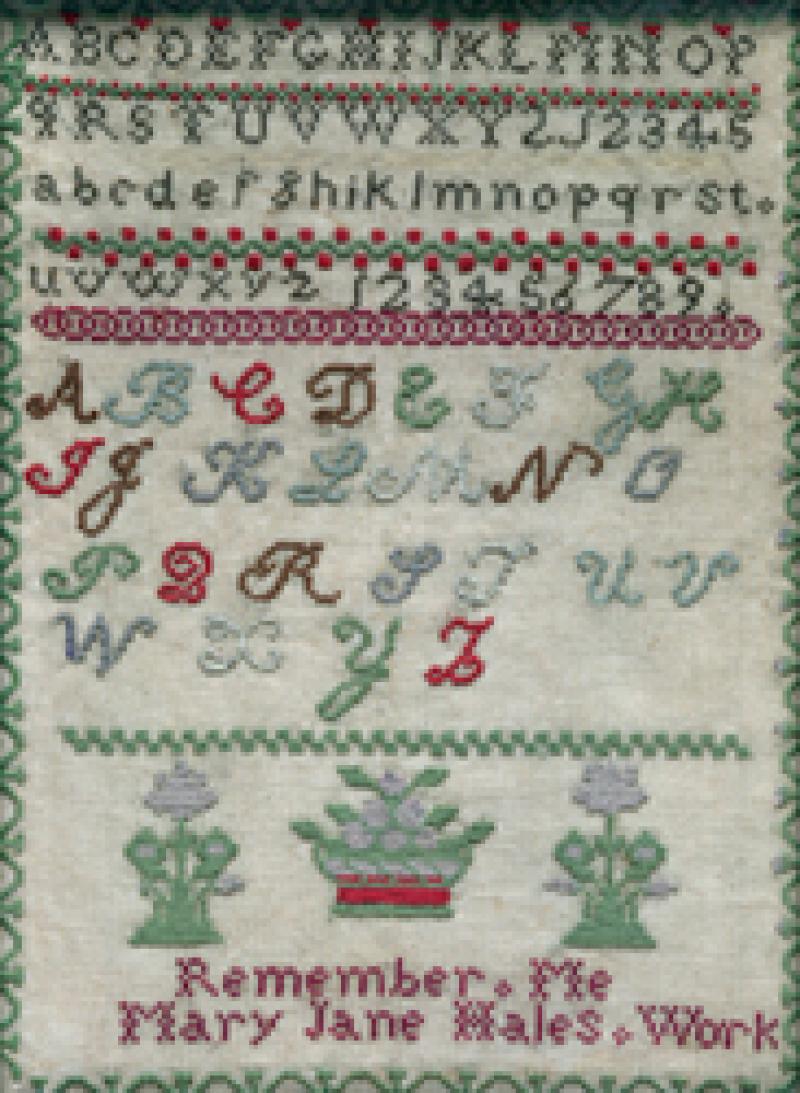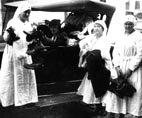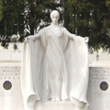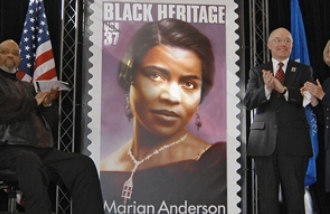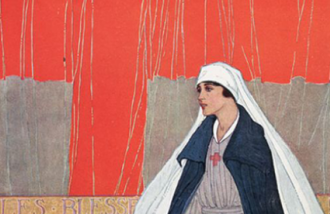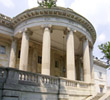To European visitors, nineteenth-century Americans appeared constantly on the move. They moved within the borders of their native states: to the Near West; to the Deep South; and finally to the “Far, Far West,” a term sometimes used to describe the vast unknown western territory. These migrations rent family life and ties.
Going Away
Sampler, about 1808 / Eliza Woodrow / Culpeper County, Virginia / Silk on muslin. Eliza Woodrow, who belonged to the Crooked Run Meeting in Virginia, worked a Quaker presentation sampler bearing the initials of her sister and brother-in-law, Mary and Francis Shinn, to commemorate their wedding and Eliza’s coming move from Virginia to Ohio. Though barely discernible, Quaker motifs fill the sampler ground. (Gift of Mrs. Mary S. Perry, great-niece of Eliza Woodrow)
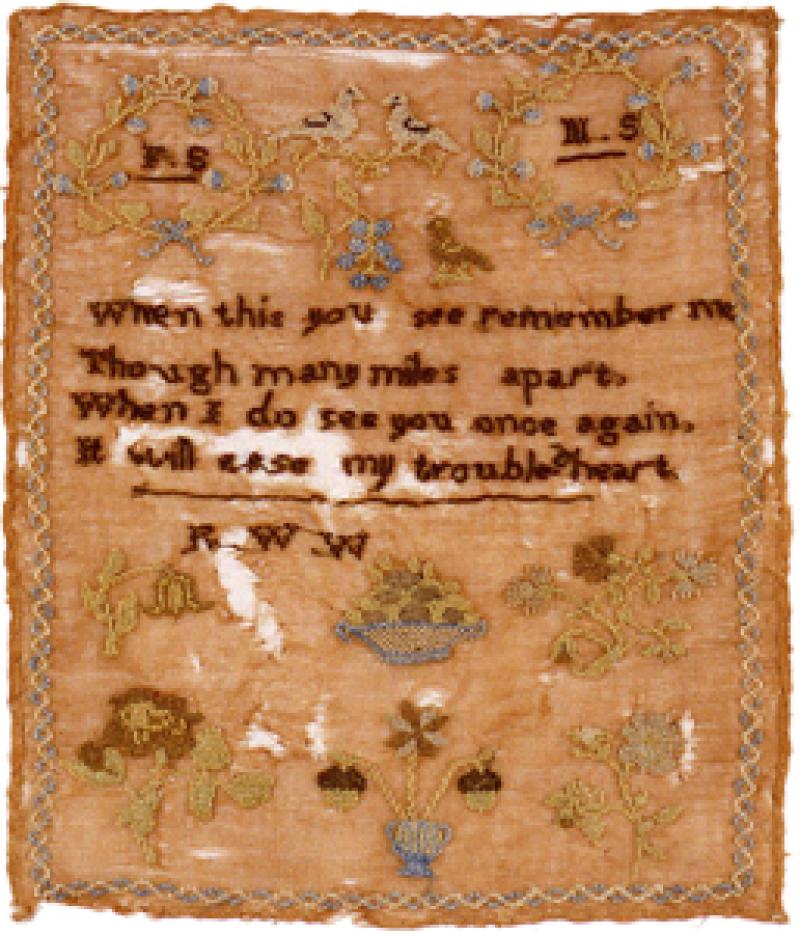
Going Away
Sampler, 1798 / Ann Trabue / Possibly Green County, Kentucky / Silk on linen. The Trabue family moved to Kentucky from Chesterfield County, Virginia before 1786, typical of the many Virginians who left their home state at the turn of the 19th century. Kentucky was a popular destination with floods of Virginia migrants coming via rivers or the Wilderness Road. Ann Trabue married William Caldwell and lived in Columbia, Adair County, in south-central Kentucky. She died there in 1846. (Gift of Mrs. Ann Rochester McAlister, granddaughter of Ann Trabue)
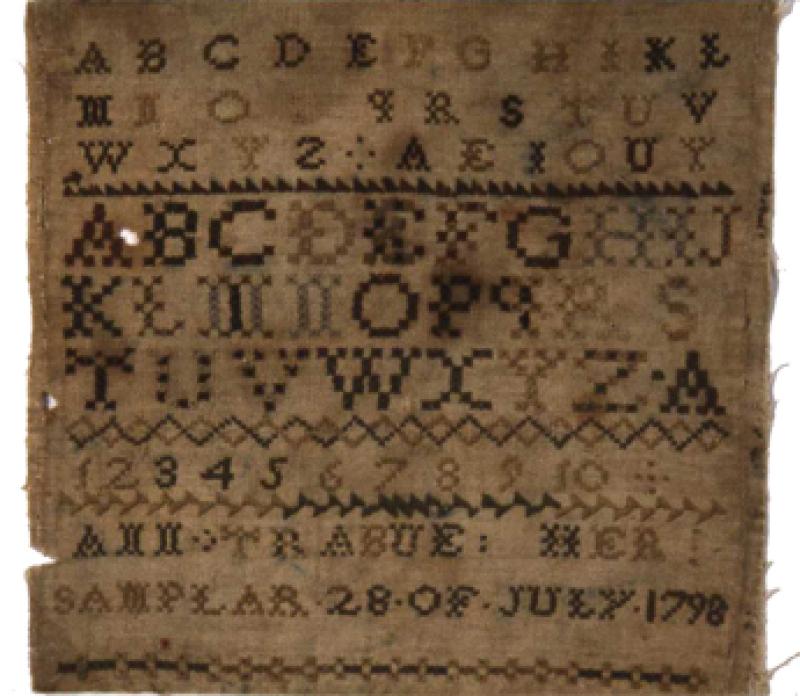
Going Away
Sampler, 1857 / Rachel Frances Spears / Rogersville Synodical College / Rogersville, Tennessee / Silk on linen. Rachel Frances Spears was the daughter of Drury and Mary Ann Spears of Hipshire Hollow, Hawkins County, Tennessee. She stitched her architectural sampler at the Rogersville Synodical College, a private female Presbyterian school, but whether it depicts an image of the school is unclear. She died, unmarried, in 1863 at the age of 21. (Courtesy of John Spears Webster. Photography courtesy of the Tennessee Sampler Survey.)
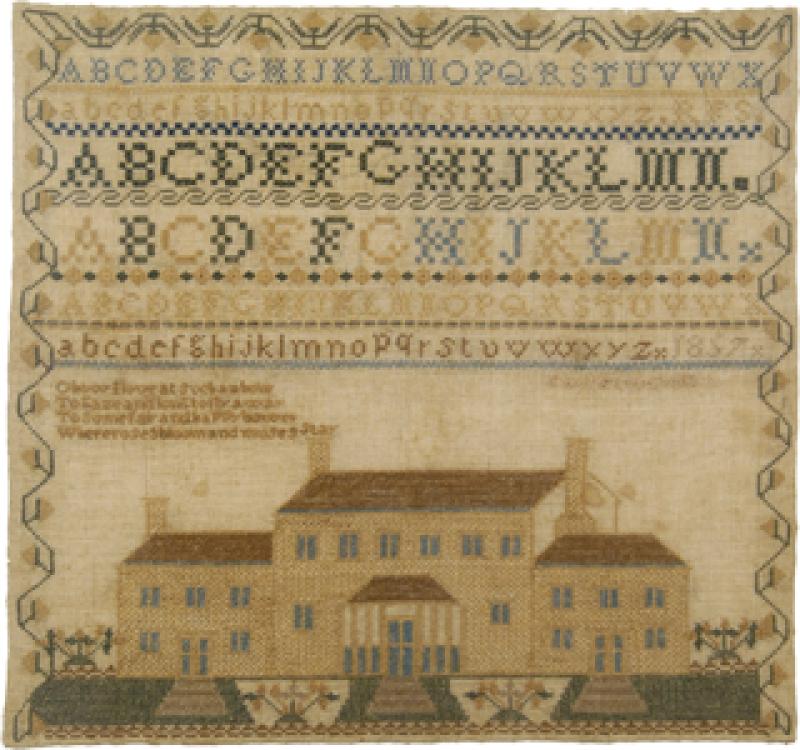
Going Away
Needlework picture, 1868 / Annis Franklin Kyle / Salem Female Academy / Salem, North Carolina / Silk and wool on linen. Annis Franklin Kyle was the daughter of Absalom Arthur and Mary Ann Kyle of Rogersville, Tennessee. She attended Salem Female Academy from 1867-1869. In 1868 when she stitched this spectacular picture, her school fee for "ornamental needlework" was $8.00. She married Judge H. S. K. Morison in 1875, and lived in Scott County, Virginia, where her six children were born. She moved to Big Stone Gap after the death of her husband in 1899, and died in 1918. (Courtesy of John Spears Webster. Photography courtesy of the Tennessee Sampler Survey.)
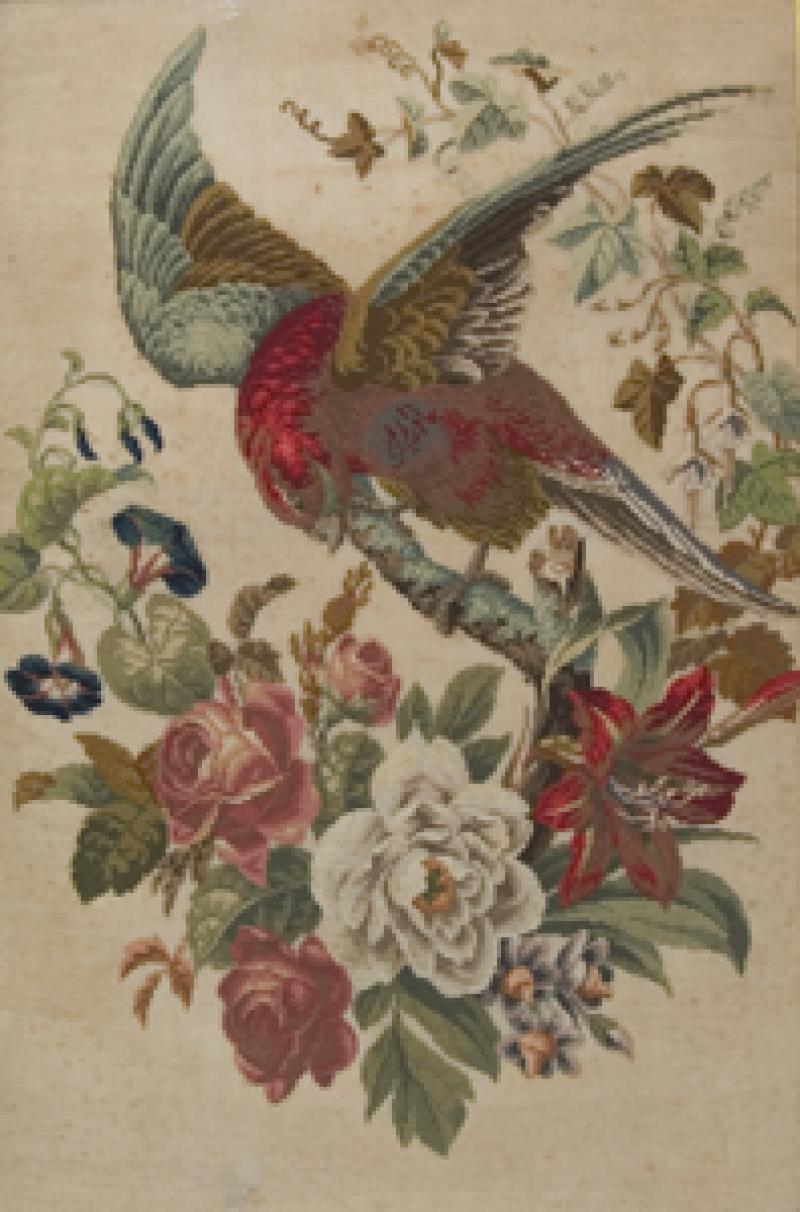
Going Away
Sampler, 1850 / Mary E. Halfacre / Union Academy / Williamson County, Tennessee / Wool on linen. Mary E. Halfacre was the oldest child of Henry and Priscilla Halfacre of Franklin, Tennessee. Mary stitched a sampler filled with floral images including a small still-life and spiraling rose vines. She enclosed her teacher’s name “Miss I. S. Wallis” in the cartouche with a verse. She married Dr. Stephen Parkes in 1855. Their infant son died at eight months; her husband’s death followed a year later. Mary later married Joseph Chadwell in 1859, but had no more children. She died in 1901. (Private collection. Photography courtesy of the Tennessee Sampler Survey.)
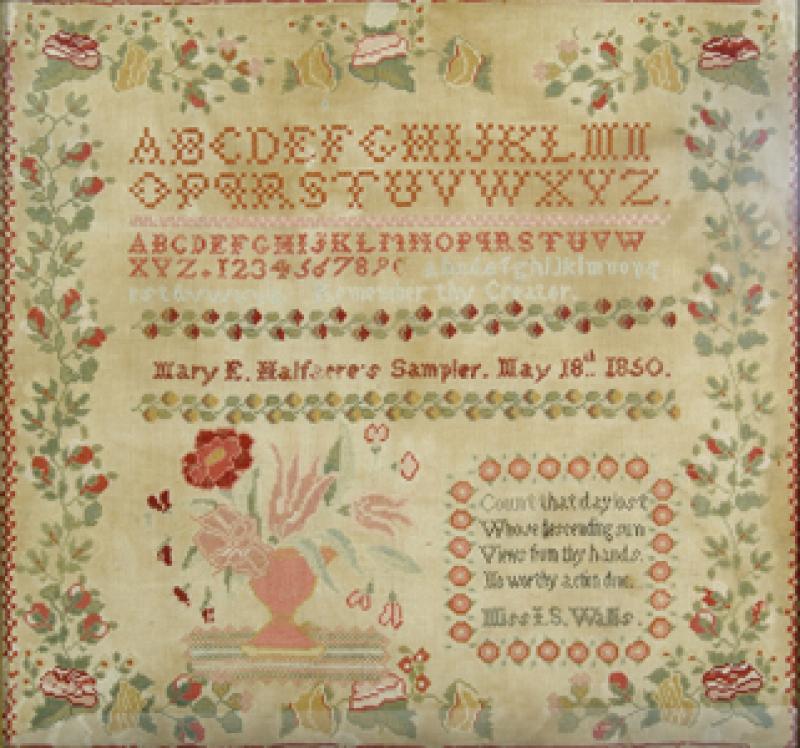
Going Away
Sampler, 1851 / Isabella S. Wallis / Union Academy / Williamson County, Tennessee / Silk on perforated paper. Isabella Wallis made this acrostic sampler for her student Mary Halfacre. Read the first letter of each line in vertical succession to find "M E HALFACRE." Isabella married Hiram Slate, a carpenter, who is listed in the Halfacre household in 1850. She and her husband had four children and eventually lived in Bedford County, Tennessee. (Private Collection. Photography courtesy of the Tennessee Sampler Survey.)
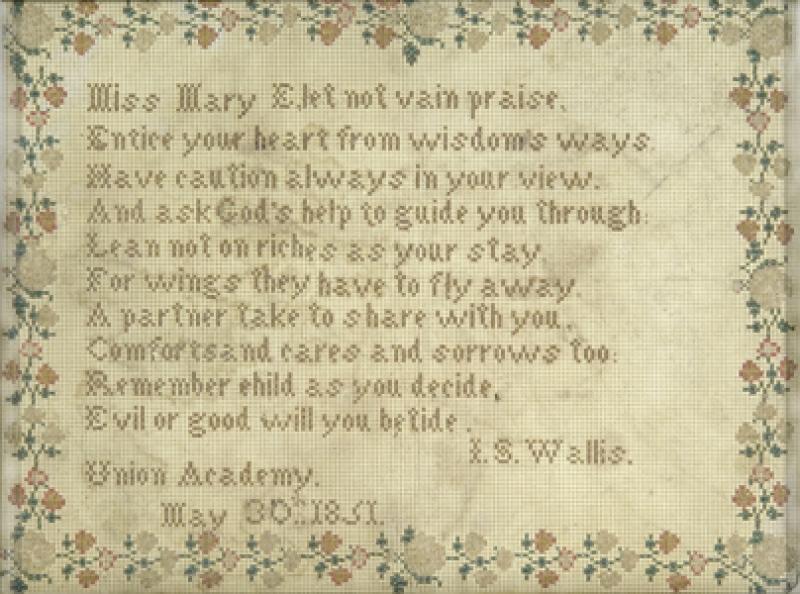
Going Away
Sampler, 1825 / Melissa Cory / Honey Creek, Ohio / Silk on linen. Melissa Cory was the daughter of Nathan and Hannah Cory, who migrated from Essex County, New Jersey and settled near Honey Creek in Clark County about 1803. Melissa, who worked this sampler when she was ten years old, was one of eleven children. She married Samuel Stafford in 1834. She died in 1860. (Bequest of Mrs. Charles H. Neff, daughter of Melissa Cory)
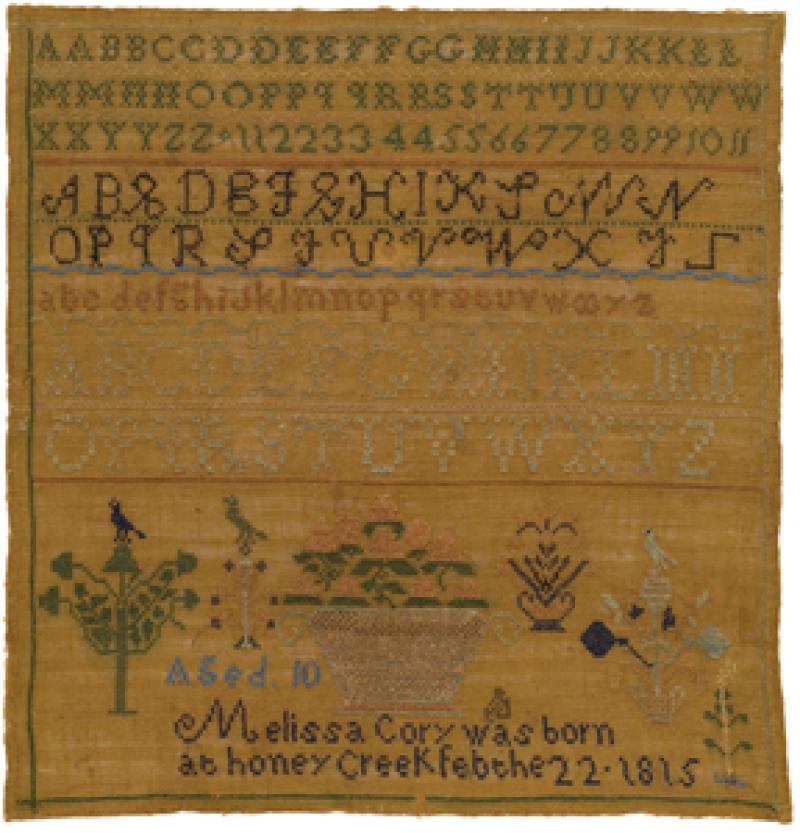
Going Away
Sampler, 1834 / Louisa Martha Vanlaw / Belmont County, Ohio / Silk on linen. John Vanlaw, Louisa’s father, came to Ohio from New Jersey, as did many Quaker settlers in the state. In 1818 Louisa was born in Belmont County, Ohio, where the Vanlaws were members of the large Stillwater Monthly Meeting. This beautiful sampler has obvious Quaker motifs, but the architectural feature is the central focus. Louisa married James Doudna in 1843 and lived until her eightieth year. (Friends of the Museum Purchase in honor of Linda B. Wetzel, Curator General NSDAR, 2004-2007)
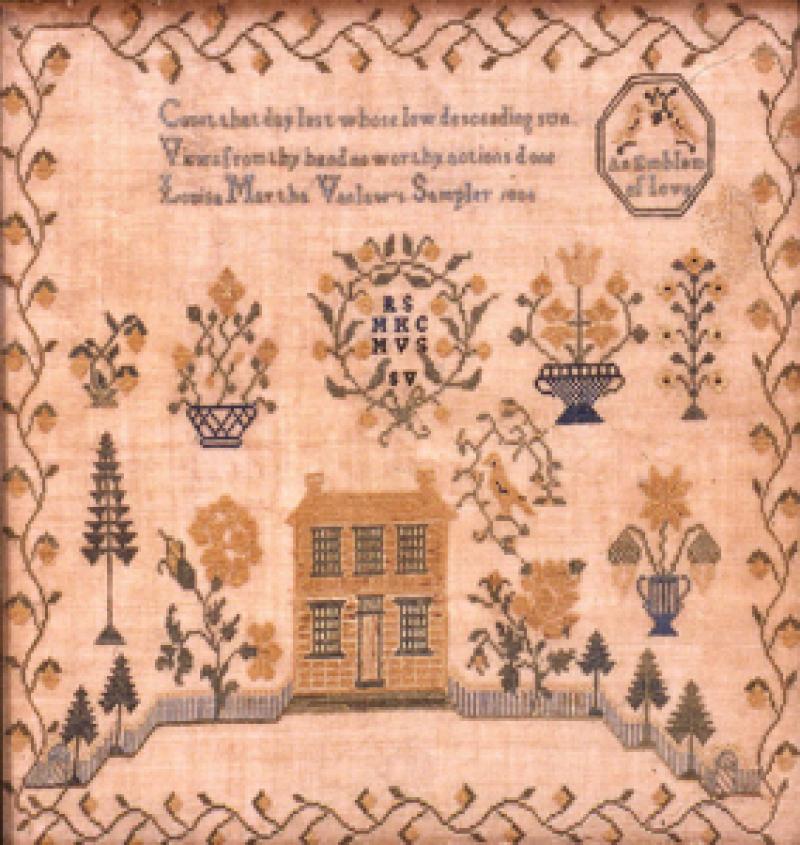
Going Away
Sampler, 1833 / Hannah Edmondson / Dayton, Ohio / Silk and wool on linen. Hannah Edmondson was born in Reading, Ohio in 1824, daughter of Edward and Ruth Ann Edmondson. Shortly thereafter, this Quaker family moved to Dayton, where in 1833 Hannah worked this marking sampler. The following year she stitched a more complicated sampler also displayed in this exhibition. Hannah married Marion Monroe in 1851. (Courtesy Pennsylvania House Museum, Lagonda Chapter Daughters of the American Revolution, Springfield, Ohio. Photography by Jack Spurlock.)
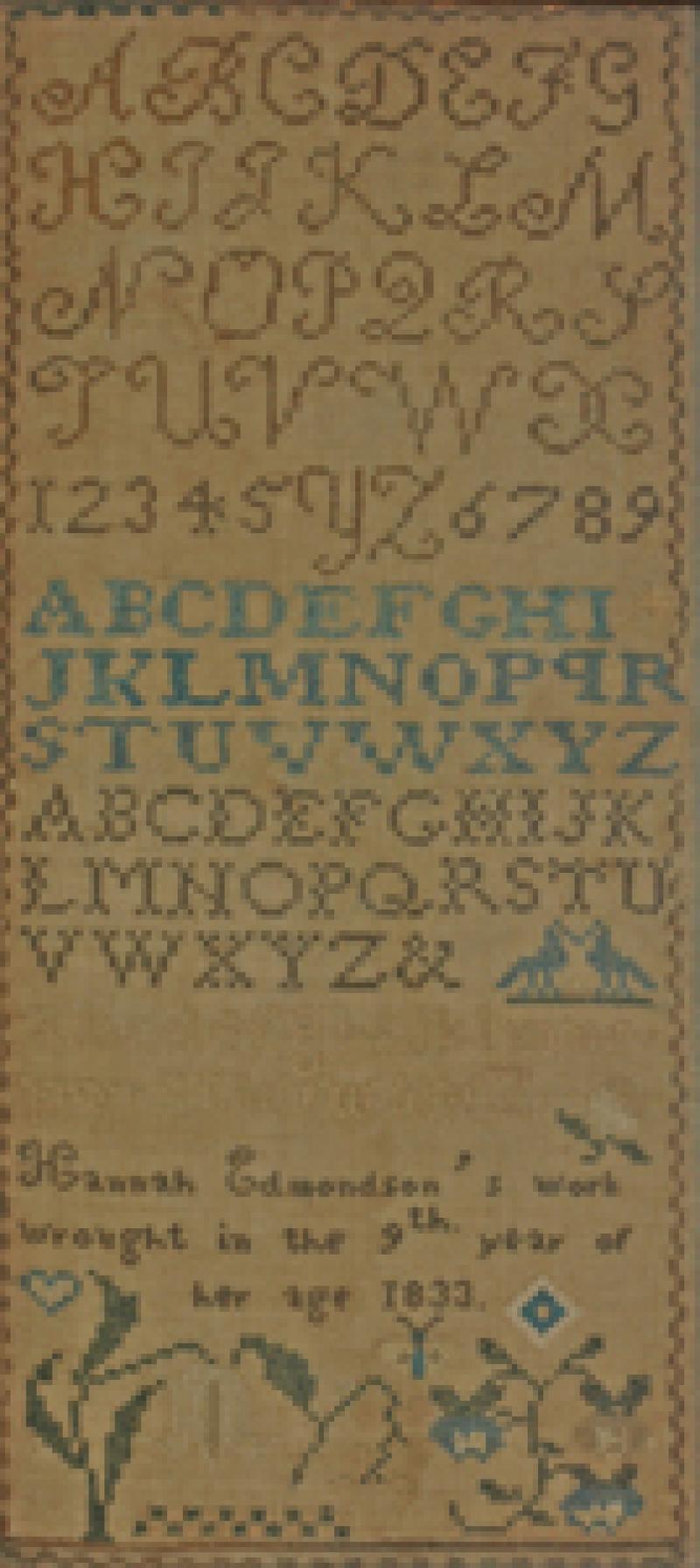
Going Away
Sampler, 1834 / Hannah Edmondson / Dayton, Ohio / Silk on linen. Hannah and two sisters, Mary Ann and Ruth Anna, worked samplers all currently in collections today, and published in Sue Studebaker’s "Ohio Is My Dwelling Place." Hannah and Mary Ann’s samplers both worked in 1834 are not identical but bear similar designs. For example, Hannah and Mary Ann included the distinctive alphabet suggestive of Scottish stitching. (Courtesy Pennsylvania House Museum, Lagonda Chapter Daughters of the American Revolution, Springfield, Ohio. Photography by Jack Spurlock.)
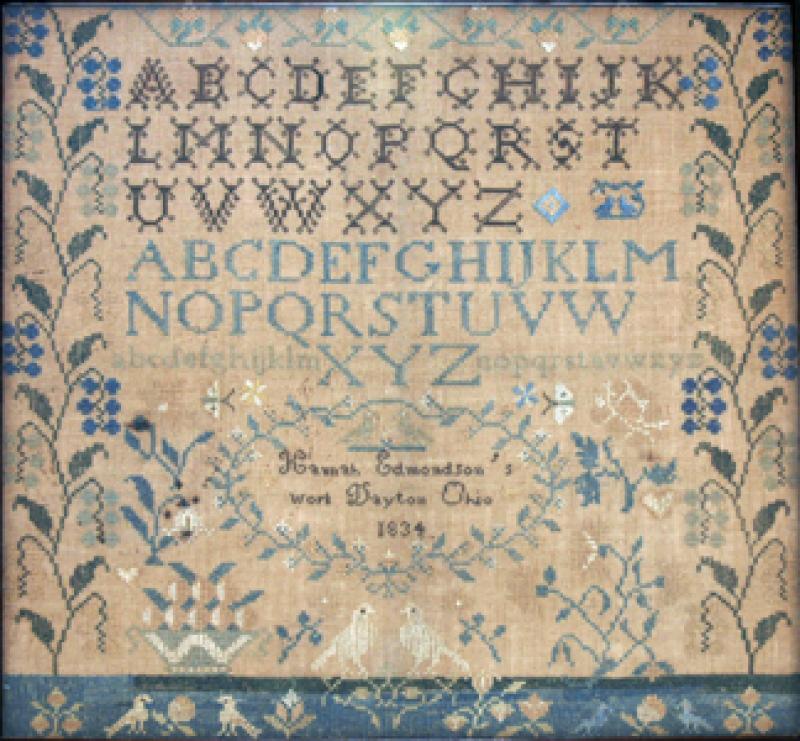
Going Away
Sampler, 1851 / Christiana Holmes Tillson / Probably Quincy, Illinois / Silk on silk; silk binding. Not until 2005 was the correct maker of this presentation sampler identified because of the identical names of mother and daughter. Christiana Holmes of Kingston, Massachusetts and her husband John Tillson were married in 1822, and left immediately for Illinois. They were true pioneers in Illinois, where John Tillson became very prosperous and influential. In 1851 Christiana made this petite presentation gift for her daughter. In 1870 her daughter persuaded Christiana to write an account of early life in Illinois. This memoir was published in 1870 and reprinted twice under the title "A Woman’s Story of Pioneer Illinois." Christiana died in 1872. (Gift of the Christiana Tillson Chapter)
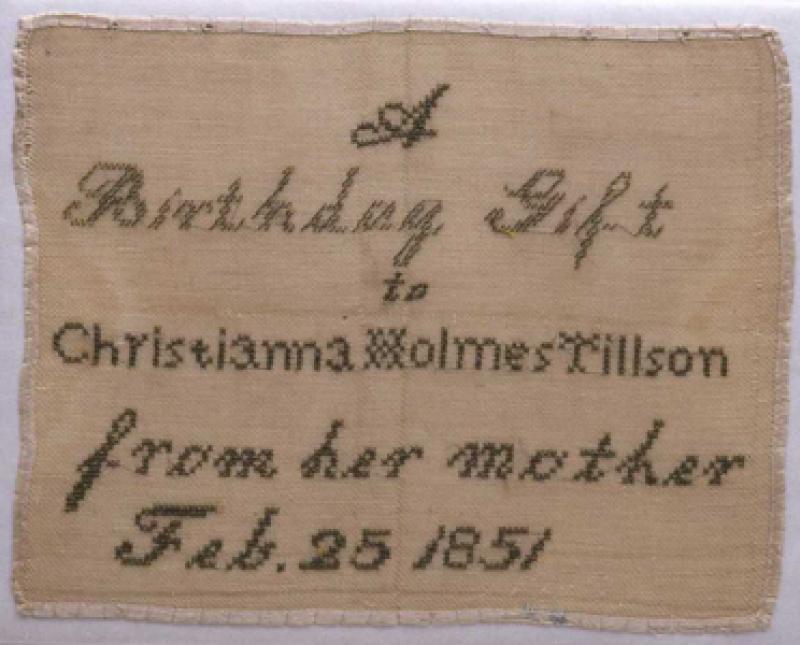
Going Away
"Christiana Holmes Tillson" / Oil on canvas / Chester Harding / Possibly St. Louis, Missouri. (Courtesy of the Historical Society of Quincy and Adams County, Illinois)
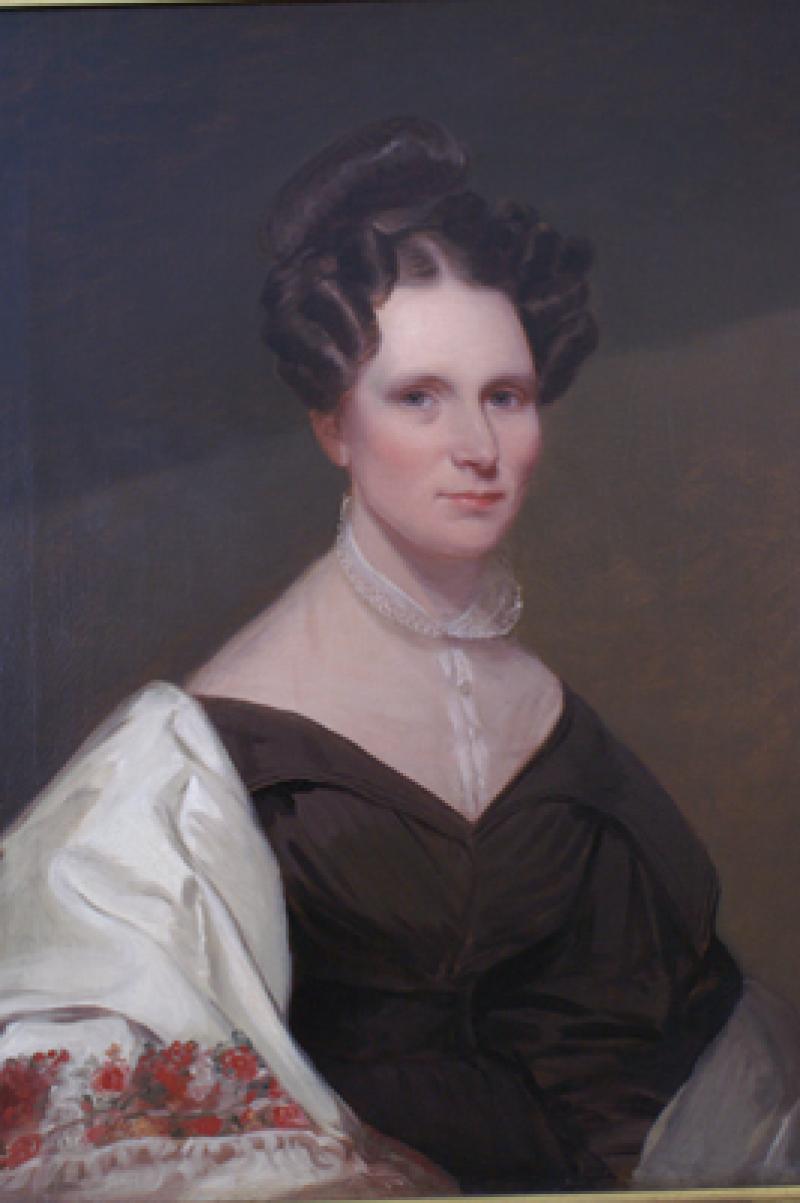
Going Away
Needlework picture, 1844 / Anna H. Brown / Richmond, Indiana / Silk on linen. At twenty-six, Anna H. Brown worked this exquisite needlework picture. There is little to suggest Anna’s strong roots in the Society of Friends except for the sprays of flowers and perhaps the large floral wreath reminiscent of early much-smaller Quaker design. However, both the marriage of her parents, migrants from North Carolina, and Anna’s marriage to Elihu Morrow, a grocer, are well-documented by the Whitewater Monthly Meeting, Richmond, Indiana. The 1880 census documents Elihu, Anna, and two of their four children as residents of Richmond. (Friends of the Museum Purchase)
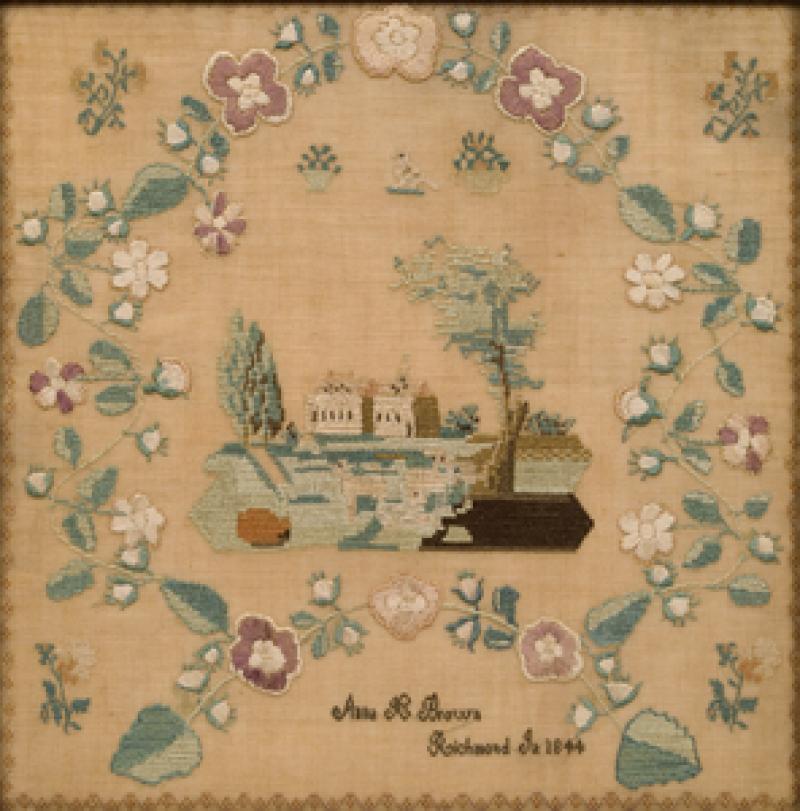
Going Away
Sampler, 1858 / Susannah McClure / Iowa City, Iowa / Wool and silk on linen. Susannah McClure was the daughter of William and Cynthia Evans McClure, devout Presbyterians who migrated from Pennsylvania to Ohio to Illinois and finally settled in 1839 in Iowa. Susannah was born in 1840, six years before Iowa statehood. Scarlet fever left her permanently deaf when she was only two, and at eight the family moved to Ohio to enroll her in the state school for the deaf. After the establishment of the Iowa Institute for the Deaf and Dumb, Susannah returned to enroll as a student. She then became a student teacher and later an instructor at this school. Here she met and married in 1865 Conrad Zorbaugh, a fellow teacher, also deaf from scarlet fever. They became the parents of seven children, with one daughter dying during a diphtheria epidemic in 1879. Susannah’s oldest son wrote of his mother’s gentleness, but also of her difficulties, "She had to contend not only with deafness, shutting her into a silent world... but much of the time after father’s teaching ended she had to struggle also with straightened circumstances." Susannah died in 1920 at the age of 80. (Friends of the Museum Purchase)
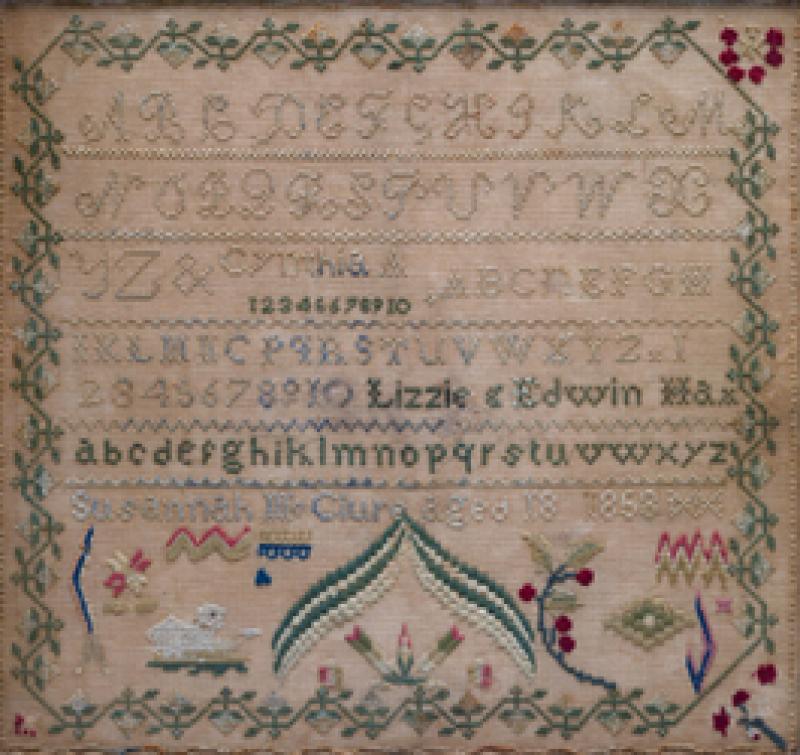
Going Away
Sampler, 1848 / Sarah J. Ridge / Dover Academy / Dover, Missouri / Wool on linen. Sarah Jane Ridge was born in Lafayette County, Missouri in 1836, the year Dover Academy was established. Sarah Jane married Lucien M. Major in 1853, and was the mother of ten children. Her husband served in the Confederate forces, and was wounded, captured, paroled and pardoned by the federal forces. Sarah, Lucien, and eight of their children are listed in the 1880 census of Lafayette County. Missouri played a large role in the journey to “the Far, Far West.” In the small Missouri towns often called “jumping off places” emigrants bought supplies, repaired their wagons, and rested their horses and mules. The stop-overs were beneficial to both parties, providing an essential service to the travelers and an economic boost to the towns. (Gift of Maryjane M. Petersen, great-granddaughter of Sarah J. Ridge)
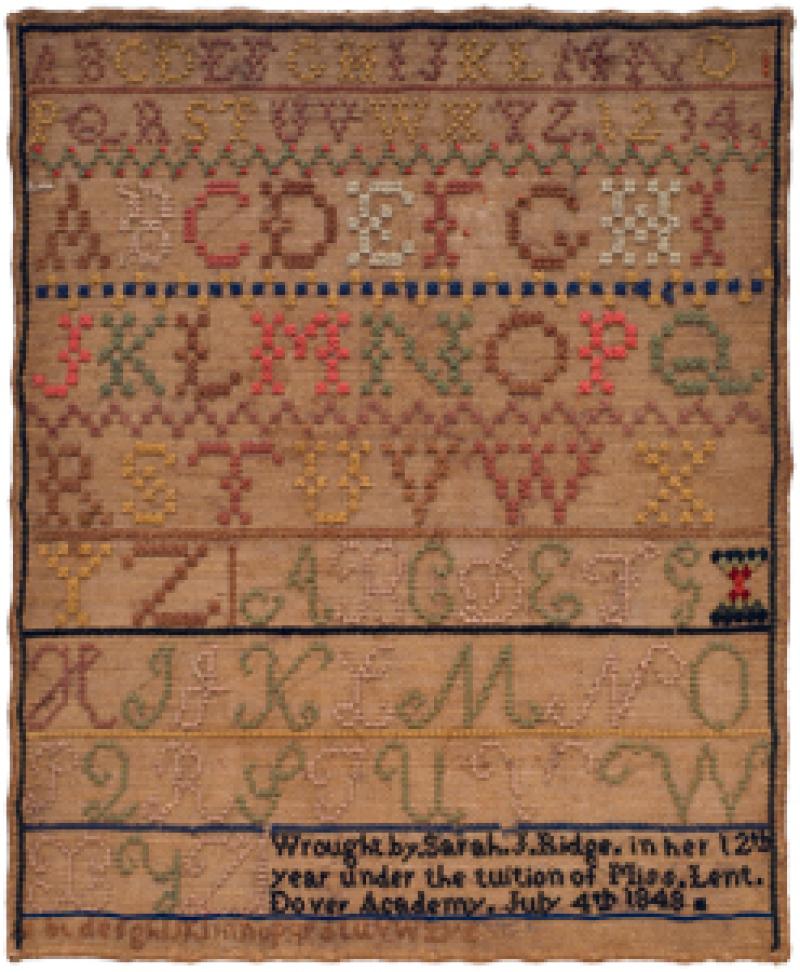
Going Away
Sampler, ca 1868 / Mary Jane Hales / Soulsbyville / Tuolumne County, California / Wool and silk on linen. Mary Jane Hales stitched "Remember Me" on this very rare California sampler. She was the daughter of John Hales and Mary Trengrove Hales, both born in Cornwall, England. John Hales sought his fortune in the California Gold Rush, and by 1860 was listed in the Tuolumne County census as a miner with a wife and three children including three-year-old Mary Jane. Ten years later, however, the census reveals he was a farmer and Mary Jane was "at school." In 1875 she married the Englishman James Trevithick, a farmer, who died in 1894. Three years later she married Alex Arthur Davis, a gold miner. She was the mother of at least six children from the two marriages. Her life seems to have come full circle in Soulsbyville during the feverish gold rush days, where many came but few found the riches sought. The sampler descended in the Trevithick family. (Gift of the California State Society in honor of Linda Gist Calvin, President General, NSDAR, 2007-2010; Nancy B. Alexander, Vice President General, 2007-2010; and Anne D. Lampman, State Regent, California State Society DAR.)
